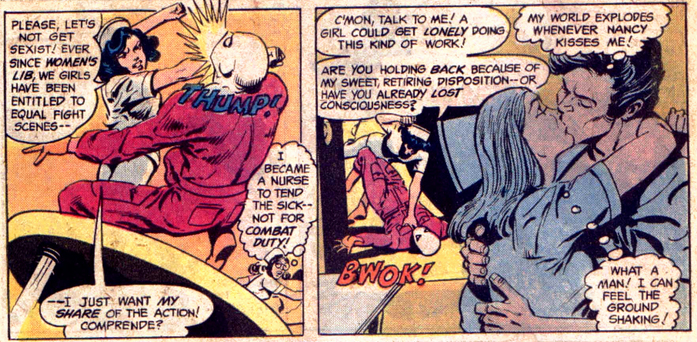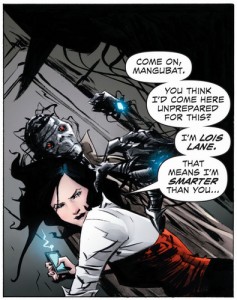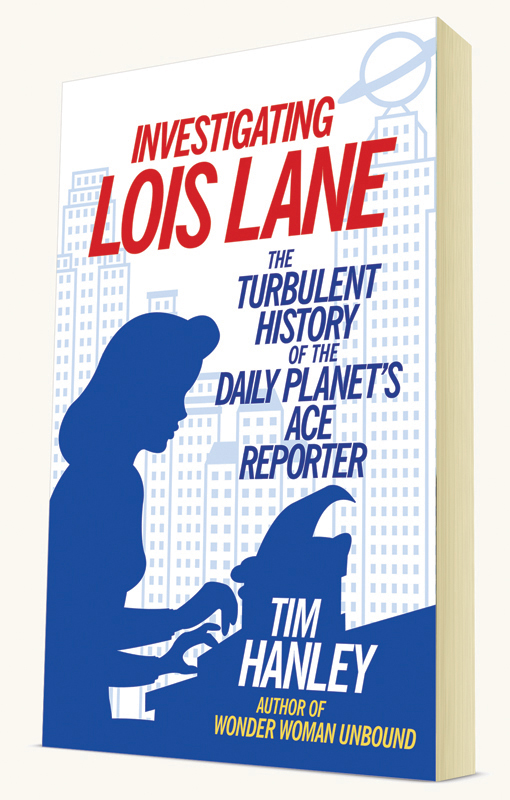 Comic books and superheroes have been a constant presence in Tim Hanley’s life. He can’t remember a time without them, from reading old yard-sale copies of Archie, Harvey, and DC comics to skimming the comic racks at the grocery store. And he didn’t stack his long boxes in the corner as he got older. While researching his honors thesis about DC Comics and the 1950s juvenile delinquency crisis, Hanley stumbled on the topic of his first book, Wonder Woman Unbound: The Curious History of the World’s Most Famous Heroine (2014). This year’s followup, Investigating Lois Lane: The Turbulent History of the Daily Planet’s Ace Reporter, hits the shelves on March 1, in advance of the release of Batman v Superman: Dawn of Justice—where Lois Lane and Wonder Woman share the screen.
Comic books and superheroes have been a constant presence in Tim Hanley’s life. He can’t remember a time without them, from reading old yard-sale copies of Archie, Harvey, and DC comics to skimming the comic racks at the grocery store. And he didn’t stack his long boxes in the corner as he got older. While researching his honors thesis about DC Comics and the 1950s juvenile delinquency crisis, Hanley stumbled on the topic of his first book, Wonder Woman Unbound: The Curious History of the World’s Most Famous Heroine (2014). This year’s followup, Investigating Lois Lane: The Turbulent History of the Daily Planet’s Ace Reporter, hits the shelves on March 1, in advance of the release of Batman v Superman: Dawn of Justice—where Lois Lane and Wonder Woman share the screen.
What compelled you to write about women in comics, specifically Wonder Woman and Lois Lane?
I was researching Dr. Fredric Wertham’s Seduction of the Innocent and the Comics Code Authority for my undergraduate thesis while I was in university, and in my reading I kept seeing references to bizarre antics in Wonder Woman comics: bondage in the 1940s, wanting to be a housewife in the 1950s, giving up her superpowers in the 1960s. So I started to read up on Wonder Woman and her history. She was more interesting than any male hero I’d ever come across, but her story was relegated to sporadic mentions while male heroes dominated the histories. This research led to me to write Wonder Woman Unbound, my attempt to give Wonder Woman the full account she deserved. In that book, I contrast Wonder Woman with several other female heroes, including Lois Lane, another absolutely fascinating character who was underserved in comic book history. As soon as I started reading Lois’s old adventures, I knew that she would be my next book. Superman always gets all of the attention, but Lois is such a huge part of comic book history and way more intriguing than that overgrown boy scout. The narratives of male heroes dominate the discourse in pop culture history (and all history, really), and I think it’s important to dig and find the overlooked histories of female characters who have had such a big impact over the decades.
What kind of research did you do, other than read a lot of comics? What other source materials helped in your research for the book?
Aside from reading thousands of comics, I watched all of the movies, television shows, and cartoons in which Lois appeared. I also got to listen to the 1966 Broadway musical It’s a Bird… It’s a Plane… It’s Superman!, as well as hours and hours of the old Superman radio show from the 1940s. It’s a tough job, but someone’s got to do it. Outside of all of the Lois fun, I got to delve into fun topics like the history of women in journalism, including some great first person accounts. I also learned all about rotoscoping, tried to solve George Reeves’ murder, and watched a ton of Mighty Mouse and Underdog. Writing this book has taken me in a lot of cool directions.
 Do you have a favorite panel or story line for Lois?
Do you have a favorite panel or story line for Lois?
So many! But a couple stand out among the rest. The first are the “Lois Lane, Girl Reporter” stories that ran in Superman in the mid-1940s. They were solo stories in which Lois investigated and battled thieves, grifters, and smugglers without any help from Superman, and they were the first comic stories that showed Lois could be a hero on her own. Plus, they were hilarious; in one issue, Lois pelted smugglers with watermelons from atop a hill. Another favorite is Tom DeFalco and Win Mortimer’s run on the “Superman’s Girl Friend Lois Lane” feature in The Superman Family. The 1970s weren’t great for Lois in the main Superman titles, but DeFalco and Mortimer told fun, exciting stories. Lois helped train a new superhero (and showed him up constantly), got some great front page scoops, and discussed the importance of women’s lib while tackling villains off hoverboards. The feature was a blast.
Lois Lane is best known for being Superman’s girlfriend. Can you tell us more about her character’s history?
As long as there have been comic book superheroes, there has been Lois Lane. She debuted in Action Comics #1 alongside Superman, and no female character has appeared in more comics and adaptations than Lois. And while she’s best known for being Superman’s girlfriend, that wasn’t her initial role; when Superman rescued Lois for the first time in Action Comics #1, Lois didn’t go gaga over him. Instead, she saw an opportunity for a story and tried to ask him some questions, and then pitched her story to her editor the next morning even though Superman specifically told her not to. The romance stuff took a few issues to develop. Lois’s fearlessness and relentlessness, often in pursuit of big stories, defined her from the get-go, and her history chronicles the competing focus between her journalistic pursuits and her romantic hijinks.
 With the publication of your book and Gwenda Bond’s YA series, it appears Lois Lane is experiencing a renaissance. What influence has Lois had on popular culture?
With the publication of your book and Gwenda Bond’s YA series, it appears Lois Lane is experiencing a renaissance. What influence has Lois had on popular culture?
Lois set the template for the love interest role in comics; it’s no coincidence that so many superheroes have reporter main squeezes. In a broader sense, Lois is to journalism as Superman is to superheroes, an archetype whose defining traits transcend comics, movies, and the rest to enter the public consciousness. Everyone knows who Lois Lane is and what she does. As for a renaissance, she’s definitely got a lot on the go right now. She’s starring in Bond’s fantastic hit series (Fallout and Double Down), and she’ll be in Batman v Superman: Dawn of Justice, played by Amy Adams. She’s also regularly mentioned on Supergirl, though unflatteringly so; I’m hoping she’ll pop up on the show soon to counter Cat Grant’s constant insults. In the comics, though, she hasn’t had a lot to do lately. She recently revealed Superman’s secret identity to save him from a villain’s blackmail but was cast in an antagonist role for doing so. I’d label it a mini-renaissance right now, but with Batman v Superman and Bond’s second Lois novel on the horizon, she’s poised to break out even more. (And when she does, Investigating Lois Lane will be there to tell you the history that led to her success.)
The comics world has changed since Jerry Siegel and artist Joe Shuster created Superman: Thor and Captain Marvel are now women, Captain America is African American, Spider-Man is biracial, and Ice Man came out. More and more women are writing, drawing, and reading comics. On paper that sounds monumental. What do these changes say about the future of comics?
These changes are great to see, though long overdue. On the character side, it’s a bit of a mixed bag because comics like to return to the status quo. Case in point, Steve Rogers will soon be back as Captain America, meaning that a Captain America will be African American because there will be two of them. Same with Spider-Man; Miles Morales is biracial but Peter Parker is still there, so he’s a Spider-Man instead of the Spider-Man. Thor as a woman has made for a fantastic comic, but the old Thor will inevitably come back; it’s just the nature of the genre. But some changes are sticking! Carol Danvers as Captain Marvel has been huge for Marvel and should stick around for a while; Ice Man coming out was a big deal that will change the character moving forward. It’s tricky to diversify a superhero world created fifty to seventy years ago, especially when the characters are so established, but big steps are being made.
Behind the scenes, the rise of female creators has been slow and slight, but things seem to be changing for the good. I keep track of creator numbers in my monthly “Gendercrunching” column at Bleeding Cool, and there have been a lot of up and downs over the last five years at DC and Marvel. A publisher will move in a positive direction with gender representation, and then the numbers will fall. There’s been a problem with consistency. But over the past year, the numbers seem to be stabilizing at a higher level, especially for female writers and artists. Outside of DC and Marvel, several of the smaller publishers have been posting much higher numbers for female creators, so the superhero publishers are playing catch up, and starting to get there. It’s a change that bodes well for the industry and should help further expand the audience, tone, and style of superhero books.
 Comics are everywhere right now—in bookstores, adapted for television, and splashed across the big screen. Why are they so popular? Do you think they’re offering more than Bam! and Kapow! entertainment?
Comics are everywhere right now—in bookstores, adapted for television, and splashed across the big screen. Why are they so popular? Do you think they’re offering more than Bam! and Kapow! entertainment?
I think, just in terms of pure practicality, it’s so much easier to make superhero movies and shows than it’s ever been. Shows like Supergirl and The Flash are pulling off crazy, fantastic-looking effects on TV every week that look as good or better than expensive superhero movies used to. So they’re not that hard to make now and there’s a wealth of source material, and the prominence of superheroes on TV and the movies is definitely affecting their presence in bookstores. But beyond that, people have to watch/read these things for them to succeed so something is certainly resonating with audiences, and I think there are a lot of factors at play. There’s the spectacle aspect, for sure; from comics to television to movies, superhero adventures are bananas and fun. They’re also classic, good vs. evil, heroes vs. villains narratives, and that has a universal appeal that crosses gender, race, and age. If we want to get really grandiose about it, there’s also the notion that superheroes are the Greek gods of the modern world, these powerful, larger than life characters whose stories say something about our world and the human condition, and who inspire us to be our best selves. Plus, there are a lot of great comics out there right now, superhero and otherwise. The industry’s upped its game considerably over the past decade, and by and large the books have never been better written or drawn than they are now. I think the movies and shows are bringing people to comics, and the quality of the comics is holding their attention.
What other comic book characters would you love to see in the spotlight? Who’s next on your list?
There are a few great female characters with fantastic comics right now that I’d love to see expand into other mediums. At DC, Batgirl and Black Canary both have new, fantastic incarnations that I think could really catch on with a wider audience if given the opportunity. Both also have fascinating histories that would be fun to explore. At Marvel, the new Ms. Marvel comic is spectacular and deserves to be huge outside of the comic book world, and both she and Captain Marvel have interesting stories behind them. As for next on my list, both Wonder Woman Unbound and Investigating Lois Lane have focused on heroes, so it would be fun to dig into a female villain next.
Tim will sign books at C2E2 (March 18-20, signing specifics TBA) and participate in the panel discussion “The Legacy of Lois Lane: Women in a World of Superheroes” at Women & Children First in Chicago on March 16, 2016.
Investigating Lois Lane officially publishes on March 1, 2016.
[Buy it now, $19] [Request a review copy]
Follow Tim on Twitter (@timhanley01) and Tumblr for more Lois Lane and Wonder Woman trivia.
1 Comment
[…] “Behind the Scenes: Tim Hanley, author of Investigating Lois Lane” at Chicago Review Pre… […]